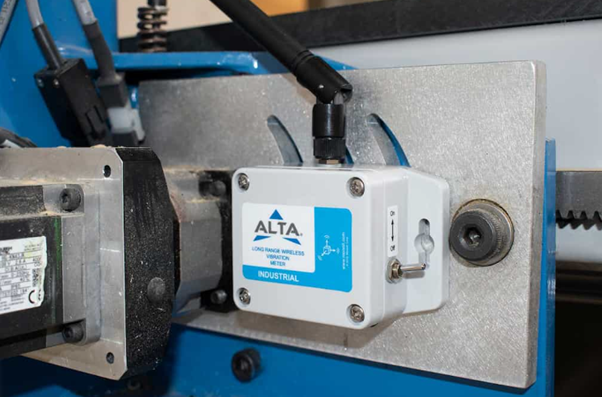
Accelerometer Vibration, Tilt & G-Force Measurement & Detection
Accelerometer - Vibration General Description
ALTA® Wireless Accelerometer - Vibration Meters measure vibration speed and frequency on three axes.
Key Features
Three axes measurement of vibration and frequency
Duty Cycle
Speed Resolution: 0.1mm/s
Frequency Resolution: 1 Hz
Configurable thresholds for critical condition monitoring
Principles of Operation
The ALTA Wireless Accelerometer - Vibration Meter measures vibration intensity and frequency on three axes (X, Y, Z) over a user-configurable time interval or Heartbeat. When performing a measurement, the sensor uses an accelerometer to capture g-force on all axes and then calculates speed and frequency from that acceleration data using time and frequency domain analysis. It also reports the duty cycle (a percentage of time during the report interval when vibration was present). On each Heartbeat, the measurements are sent to the gateway, making the data available in iMonnit or other approved data services.
Accelerometer - Tile Detection General Description
ALTA® Wireless Accelerometer - Tilt Detection Sensor is a micro-electromechanical systems (MEMS) sensor that continuously measures changes in tilt on a single axis of rotation.
Key Features
Two modes of operation
Up/Down detection mode: Up, down, stuck
Delta detection mode: Report on change
Axis of rotation is user-selectable
Measurement:
- Range: -179.9° to +180.0°
- Resolution: 0.01°
- Accuracy: +/- 0.5°
Configurable thresholds for critical condition monitoring
Principles of Operation
The ALTA Wireless Accelerometer - Tilt Detect Sensor continuously monitors a single axis of rotation specified by the user. The sensor has two modes of operation. In Up/Down mode the sensor is triggered when its pitch changes between user configurable angles defined as Up, Down, and Stuck. In Delta mode the sensor is triggered when the absolute difference between the current sensor angle and the last reported angle exceeds a user-defined Delta Value. On a user-configurable time interval or Heartbeat, or when the sensor is triggered, the current measurement is then sent to the gateway, making the data available in iMonnit or another approved data service.
Accelerometer - G-Force General Description
ALTA® Wireless Accelerometer - G-Force Max-Avg Sensors measure the maximum and average g-force levels that occur on the X, Y, and Z axes over a user-defined report interval.
Key Features
Measures on three axes
Resolution: 0.001 g
Accuracy: ±2.5% on all axes
Range: 2 g, 4 g, or 8 g
High Pass Filter (HPF) optional to remove static forces
Configurable thresholds for critical condition monitoring
Principles of Operation
The ALTA Wireless Accelerometer - G-Force Max-Avg Sensor uses a MEMS (microelectromechanical system) accelerometer to measure and record acceleration over a user-configurable time interval or Heartbeat. On every Heartbeat, the data collected is analyzed, and Max and Average results are forwarded to the gateway, making the data available in iMonnit or another approved data service.
Features of Monnit ALTA Sensors
Wireless range of 2,000+ feet through 18+ walls1
Frequency-Hopping Spread Spectrum (FHSS)
Best-in-class interference immunity
Best-in-class power management for longer battery life2
Encrypt-RF® Security (Diffie-Hellman Key Exchange + Advanced Encryption Standard (AES)-128 Cipher Block Chaining (CBC) for sensor data messages)
Sensor logs 2000 to 4000 readings if the gateway connection is lost (non-volatile flash, persists through power cycling):
10-minute Heartbeats = ~ 22 days
2-hour Heartbeats = ~ 266 days
Automatic over-the-air updates to sensor firmware (future-proof)
Free iMonnit Basic Online Wireless Sensor Monitoring and Notification System to configure sensors, view data, and send alerts via SMS text, email, and voice call
1 Actual range may vary depending on the environment and gateway.
2 Battery life is determined by the sensor reporting frequency and other variables. Other power options are also available
>>Datasheet (Accelerometer - Vibration)
>>Datasheet (Accelerometer - Tilt)
>>Datasheet (Accelerometer - G-Force)
SL Process Measurement Pte Ltd
50 Gambas Crescent,
#10-15 Proxima@Gambas,
Singapore 757022
Kuala Lumpur, Penang
Tel / Whatsapp: +6011 55524838
Email: sl@slmeasurement.my
© 2024-2025. All rights reserved.
Johor, Singapore
Tel / Whatsapp: +65 87422778
Email: sl@slmeasurement.com.sg
Contact us for inquiries and professional support.

